Email Automation
Email Automation Best Practices
Pique your curiosity with the best practices for email automation, and discover how to maximize engagement and conversions.
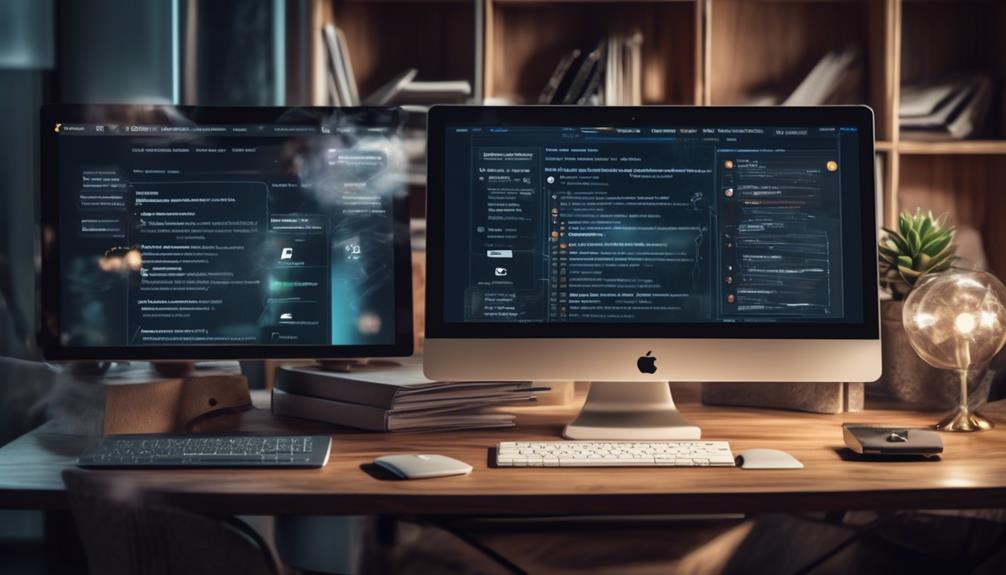
We all know about the data showing that the return on investment (ROI) for email marketing stands at an impressive 3800%. However, what strategies can we deploy to guarantee that our email automation efforts are fully capitalizing on this opportunity?
It's not just about setting up a series of automated emails and hoping for the best. There are key best practices that can make or break the success of your email automation efforts.
From personalization and segmentation to testing and optimization, the strategies we implement can significantly impact our results.
So, what are these best practices, and how can we effectively implement them to drive better engagement and conversions?
Key Takeaways
- Tailor workflows to target audience and goals
- Utilize recipient-specific information and segment audience based on preferences and behavior
- Provide value before making direct requests and personalize requests to align with audience's interests
- Track metrics, experiment with different approaches, and refine strategies for more efficient and impactful workflows
Planning Your Workflows
We meticulously plan our email workflows, ensuring they're tailored to our target audience and designed to achieve our specific goals.
To excel in email marketing, it's crucial to define our target audience and identify the types of workflows we want to implement. By mapping out the structure of each workflow, including branching paths and messages, we can visualize and plan our workflows ahead of time.
This approach allows us to personalize email content, senders, and subject lines, thereby increasing open and engagement rates. Additionally, planning the use of static and automatic entry triggers enables us to control when individuals enter the workflow, ensuring flexibility in our automation.
Setting clear goals for each workflow is also essential to track success and make improvements. By aligning our workflow plans with our goals and deadlines, we can ensure that our email marketing efforts are strategic and effective.
These meticulous planning practices are fundamental in implementing successful marketing automation best practices.
Personalizing Email Content
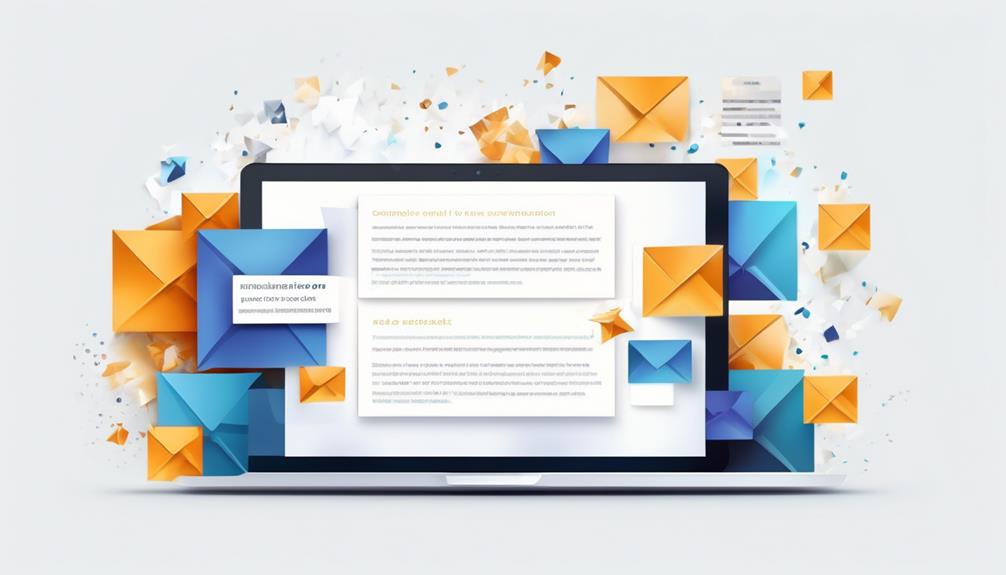
To enhance recipient engagement and relevance, personalizing email content involves tailoring the message to resonate with the individual on a deeper level. By incorporating personalization into your email content, you can create a more meaningful and impactful connection with your audience.
Here are three key strategies for effectively personalizing email content:
- Utilize recipient-specific information: Incorporate the recipient's name, previous interactions, or specific interests to make the email content feel more customized and relevant to their needs and preferences.
- Segment your audience: By segmenting your audience based on their preferences and behavior, you can send targeted and tailored content that aligns with their interests, leading to higher engagement and conversion rates.
- Personalize sender details: Personalize not only the email content but also the sender's name and the subject line to make the communication feel more authentic and individualized, increasing the likelihood of recipient engagement.
Implementing these personalized email content strategies as part of your Email Automation Best Practices can significantly improve the effectiveness of your email campaigns, leading to higher open rates, click-through rates, and overall engagement.
Personalizing Senders
Crafting personalized sender details is a crucial aspect of enhancing email open rates and recipient engagement. When the sender's name resonates with the recipient, it creates a sense of trust and familiarity, leading to higher open rates and increased engagement. Utilizing personalization in the sender field can significantly impact the effectiveness of email campaigns. Take a look at the table below to see the impact of personalized senders and subject lines on email open and engagement rates:
| Personalized Sender | Email Open Rate | Recipient Engagement |
|---|---|---|
| Individual's Name | High | High |
| Department Name | Moderate | Moderate |
| Generic Company | Low | Low |
| No Personalization | Very Low | Very Low |
| Misspelled Name | Very Low | Very Low |
As demonstrated in the table, personalizing the sender field with an individual's name yields the highest open rates and recipient engagement. It's clear that personalization of senders is a crucial component of successful email automation, and it's essential to implement this practice to optimize campaign performance.
Personalizing Subject Lines
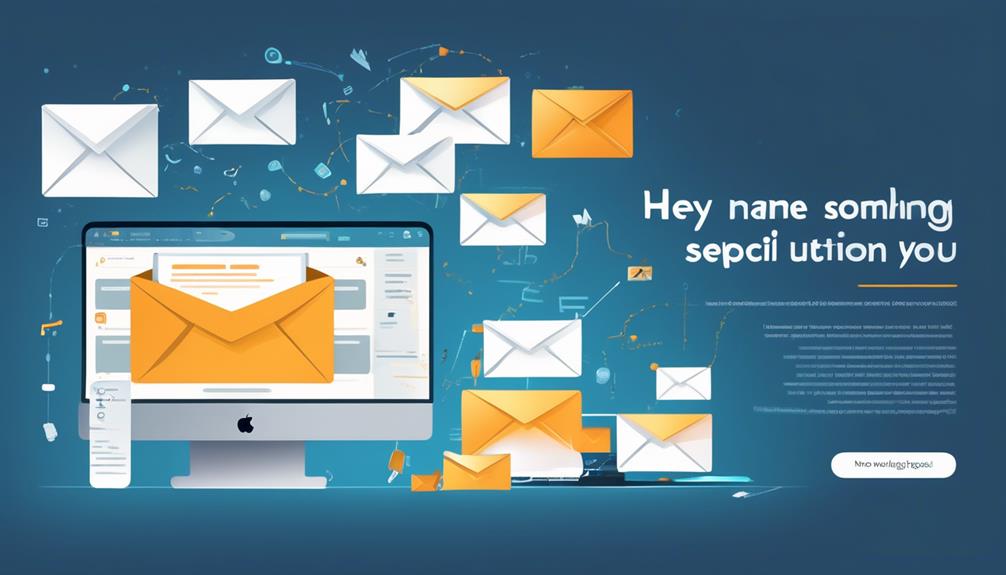
Personalizing subject lines is a key strategy for boosting email open rates and recipient engagement. By incorporating personalized details, such as the recipient's name, location, or past interactions, into subject lines, we can create a more tailored and engaging experience for the recipients.
Using dynamic content to customize subject lines based on the recipient's behavior or preferences further enhances the personalization. Experimenting with different subject line personalization strategies allows us to discover what resonates best with our audience and refine our approach accordingly.
Analyzing data and performance metrics is essential for optimizing personalized subject lines and ensuring improved engagement. Personalizing subject lines not only increases open rates but also fosters a stronger connection with recipients, ultimately leading to higher engagement and conversion rates.
In mastering email automation best practices, personalizing subject lines is crucial for creating impactful and engaging email campaigns.
Being Cautious With Requests
After incorporating personalized details into subject lines to enhance recipient engagement, it is essential to be cautious with how we approach requests in our email automation strategies. When it comes to email marketing, bombarding our audience with requests can lead to disengagement and even prompt them to unsubscribe. Instead, we should focus on providing value before making direct requests. This can be achieved by sending two to three emails ahead of each request, offering helpful information that aligns with the audience's interests and needs.
To illustrate the importance of being cautious with requests, let's take a look at the following table:
| Common Mistakes | Best Practices |
|---|---|
| Asking for too much too soon | Send informative emails before making a direct request |
| Failing to explain the impact | Clearly articulate why the request matters and its impact |
| Neglecting to show gratitude | Send a personalized thank you email after a request |
| Overlooking audience needs | Tailor requests to align with the audience's interests |
Planning Entry Triggers
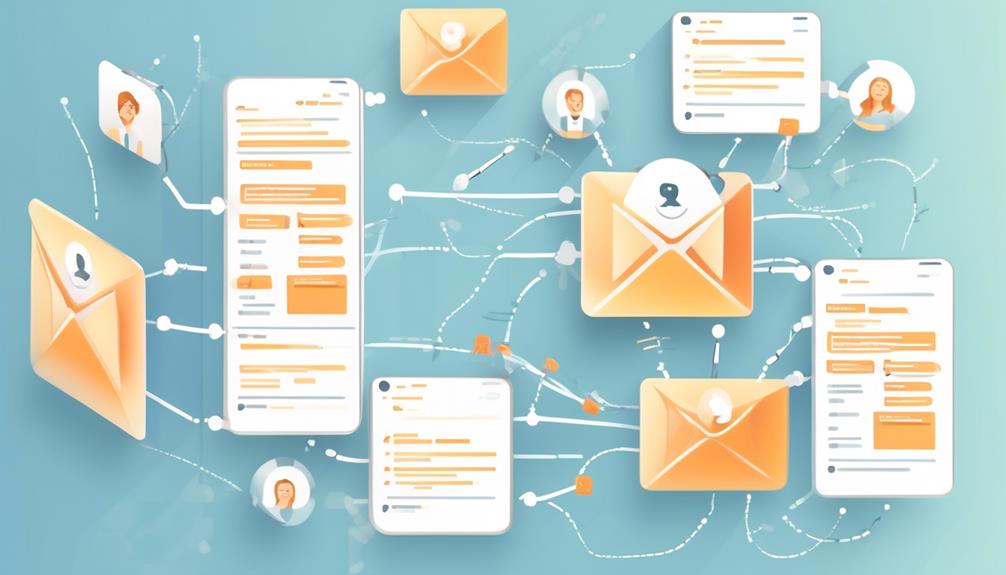
Planning entry triggers is crucial for effectively managing the flow of individuals into the workflow. When it comes to email automation, strategic planning of entry triggers can make a significant impact on the overall effectiveness of your campaigns.
Here are three key considerations to keep in mind when planning entry triggers:
- Align with Goals and Deadlines: It's essential to ensure that the entry triggers align with the overarching goals and deadlines of your email automation campaign. By doing so, you can maintain a coherent and purposeful flow of individuals into the workflow, ultimately contributing to the achievement of your objectives.
- Define Target Audience and Workflows: Clearly defining your target audience and the types of workflows you want to implement is fundamental. This allows for the precise configuration of entry triggers tailored to the specific needs and behaviors of your audience, enhancing the relevance and impact of your automated emails.
- Visualize Workflow on Paper: Before implementing entry triggers using automation software, take the time to map out the workflow on paper. This practice provides a visual representation of the entry points and paths individuals will take, enabling better decision-making and optimization.
Setting Workflow Goals
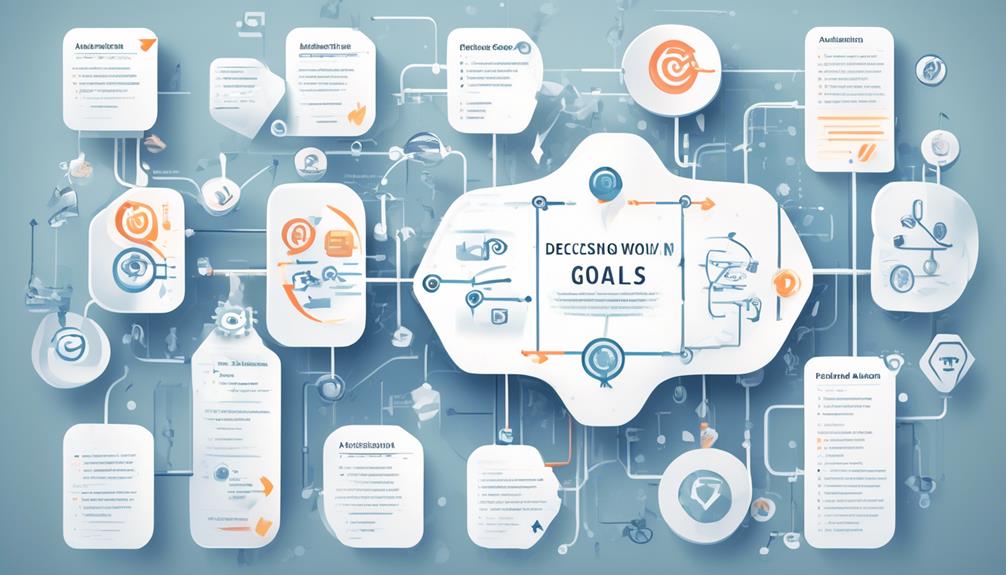
When it comes to optimizing email automation, the next step is to clearly define the specific goals for the workflow, ensuring they're measurable and aligned with our overall marketing objectives. Setting workflow goals is a critical component of email automation best practices. These goals should be specific, attainable, and relevant to the overall marketing strategy. By establishing clear objectives, we can effectively measure the success of our email automation efforts and make data-driven decisions to enhance performance.
In setting workflow goals, it's essential to consider the impact on our target audience and their journey. The goals should align with the different stages of the customer journey, providing value and relevance at each touchpoint.
Additionally, setting realistic timelines and milestones for reaching these workflow goals is crucial for tracking progress and making necessary adjustments along the way.
As part of email automation best practices, it's important to regularly review and adjust workflow goals based on performance and feedback. This iterative approach allows us to refine our strategies and ensure that the workflow goals continue to align with the evolving needs of our audience and the overall marketing objectives.
Avoiding Unwanted Emails

To minimize the likelihood of receiving unwanted emails, employ double opt-in mechanisms to ensure that subscribers genuinely want to receive our emails. This process requires subscribers to confirm their email addresses and express consent to receive communication from us.
Additionally, clearly outline the frequency and type of content subscribers can expect to receive when they sign up. By setting transparent expectations, subscribers are less likely to feel surprised or overwhelmed by the emails they receive, leading to a more positive and engaged audience.
Furthermore, provide easy and visible unsubscribe options in every email to give recipients control over their subscriptions. This demonstrates respect for their preferences and can help to retain their goodwill even if they choose to opt out.
Lastly, respect local and international laws, such as CAN-SPAM and GDPR, regarding email consent and privacy. Adhering to these regulations not only demonstrates ethical conduct but also helps to avoid potential legal issues related to unwanted emails.
Incorporating these practices into our email automation strategy will foster a more engaged and satisfied subscriber base while also ensuring legal compliance.
Implementing Message Delays
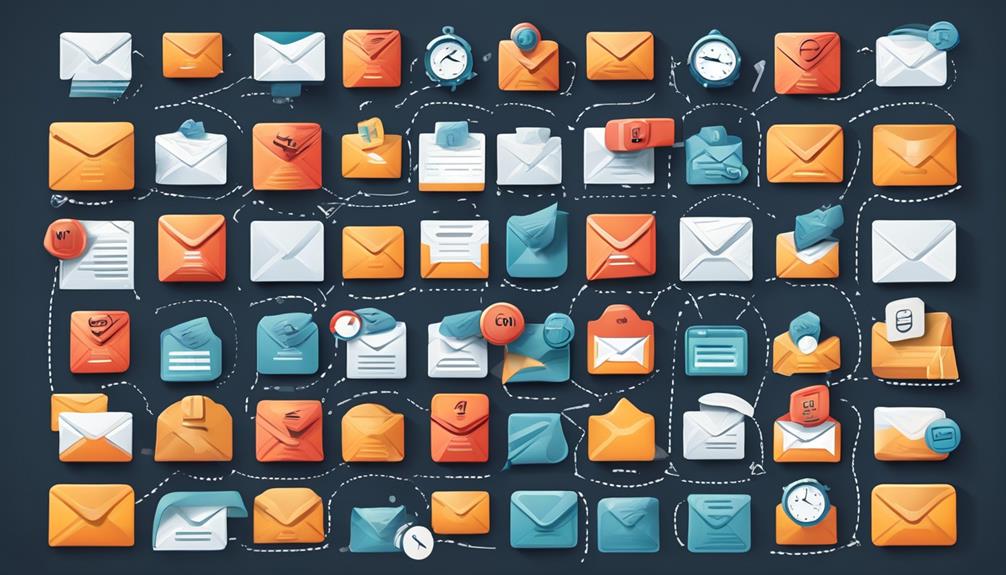
To build on our strategy for managing unwanted emails, we can now explore the implementation of message delays in our automated email workflow to ensure a more effective and engaging communication approach. Utilizing message delays is crucial in email automation as it allows us to pace the delivery of our emails, preventing recipients from feeling overwhelmed by receiving multiple messages in a short time frame. By strategically incorporating message delays, we can enhance the overall engagement with our emails. These delays provide recipients with time to engage with previous emails, ultimately leading to improved open and click-through rates.
Implementing message delays can be done by introducing intervals between different stages of the email workflow. This gradual progression allows recipients to move naturally through the email sequence and increases the likelihood of them eagerly anticipating upcoming messages. By doing so, we can create anticipation and excitement, resulting in higher engagement and interaction with our email content.
Learning From Past Workflows
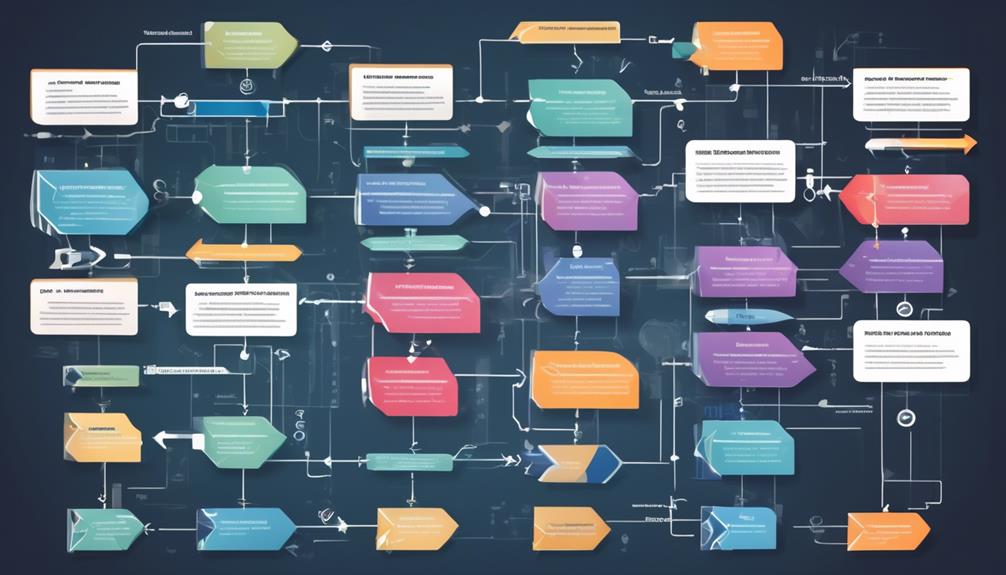
As we reflect on our past workflows, we gain valuable insights into their performance and effectiveness. By tracking metrics such as open rates, click-through rates, and conversion rates, we can identify areas for improvement and optimization.
This analysis allows us to make data-driven decisions and experiment with different approaches, ultimately leading to more efficient and impactful email automation workflows.
Workflow Analysis
Learning from our past workflows allows us to:
- Identify areas for improvement
- Track metrics
- Make data-driven decisions to continuously enhance our email automation campaigns.
When analyzing past workflows, we can:
- Experiment with different approaches
- Generate a sense of excitement and innovation as we strive for continuous improvement.
By learning from what worked well and what didn't, we feel a sense of empowerment, knowing that we can:
- Optimize future workflows based on real data and insights.
Applying these insights to make informed decisions creates a feeling of confidence and assurance in the effectiveness of our email automation campaigns.
Utilizing past workflow data to make informed adjustments evokes a sense of mastery and control, knowing that we can:
- Optimize email content
- Enhance overall workflow performance.
Efficiency Improvements
How can we capitalize on our past workflow data to drive efficiency improvements in our email automation campaigns? Analyzing the performance of past workflows is crucial for identifying areas that can be optimized to enhance efficiency. By tracking metrics such as open rates, click-through rates, and conversion rates, we can make data-driven decisions to improve future workflows. Experimenting with different approaches allows us to determine the most effective strategies. Continuous learning and improvement are essential for successful email automation. Utilizing marketing automation tools can significantly save time and streamline processes. Below is a table summarizing key efficiency improvement strategies:
| Efficiency Improvement Strategies | Description | Benefits |
|---|---|---|
| Analyze past workflow performance | Identify areas for optimization | Improve targeting and engagement |
| Track key metrics | Assess the effectiveness of campaigns | Enhance decision-making |
| Experiment with different approaches | Test new strategies | Refine email automation tactics |
Following Up on Customer Behavior
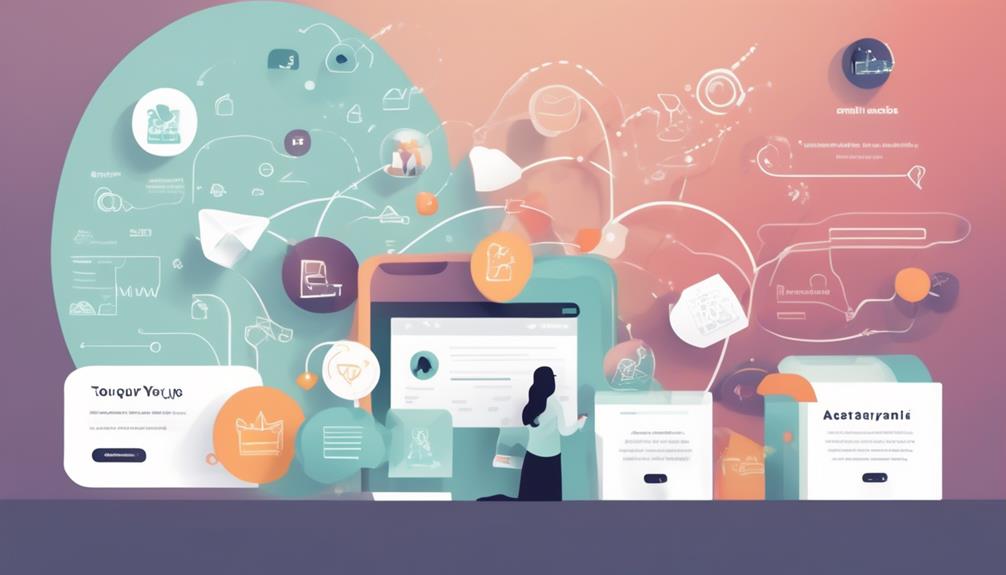
We can use behavior-based triggers to automatically send follow-up emails based on customer actions.
By tailoring our follow-up strategies to the specific product or service the customer has shown interest in, we can increase the relevance and effectiveness of our communications.
It's essential to implement short-term follow-up strategies for immediate engagement and long-term nurture sequences for sustained customer relationships.
Behavior-Based Email Triggers
Behavior-based email triggers should be used to follow up on customer interactions when businesses aim to deliver timely and personalized communication. Leveraging automated emails based on customer behavior allows for tailored responses that can significantly improve engagement and conversion rates.
Businesses can enhance customer satisfaction and nurture leads effectively by utilizing behavior-based email triggers to send targeted follow-up messages. Moreover, these triggers enable businesses to create a more responsive and customer-centric email marketing strategy, leading to stronger customer relationships and brand loyalty.
- Increase customer engagement through personalized communication.
- Improve conversion rates by delivering timely follow-up messages.
- Nuture leads effectively with targeted automated emails.
Personalized Follow-Up Emails
Following up on customer behavior through personalized emails is a crucial strategy for businesses aiming to enhance customer engagement and drive conversions. By utilizing customer behavior data, businesses can create personalized follow-up emails triggered by actions like website visits, product views, or abandoned carts.
Tailoring the content and timing of these emails to individual customer actions can significantly increase engagement and drive conversions. Implementing an automated system to track and respond to customer behavior enables timely and relevant follow-up emails to be sent, further enhancing the effectiveness of this strategy.
Additionally, segmenting the audience based on customer behavior data allows for the sending of personalized follow-up emails that cater to specific interests and actions, contributing to a more targeted and effective approach in email automation best practices.
Building Follow-Ups in Campaigns
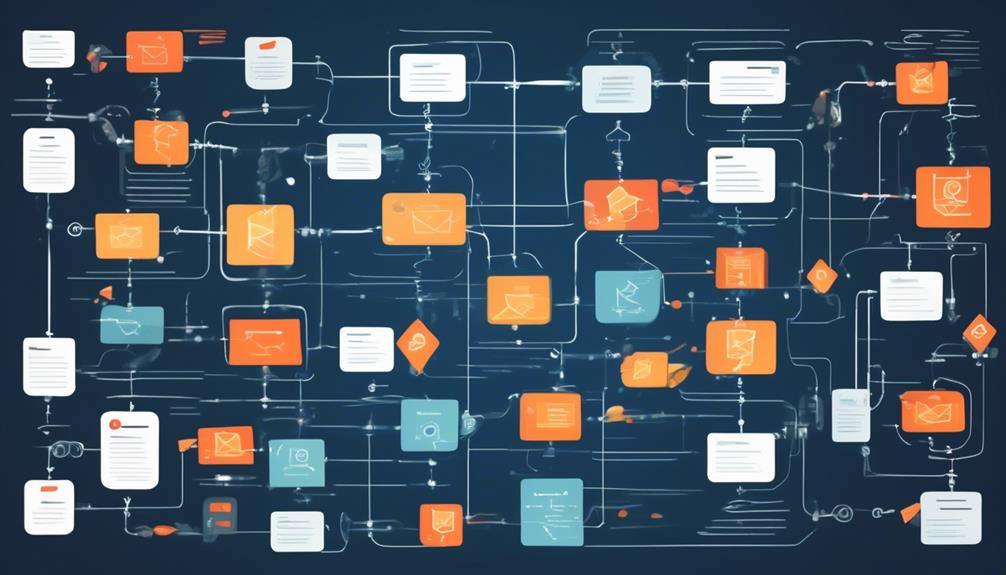
Building effective follow-up campaigns in email automation requires thoughtful consideration of behavior-based triggers and tailored strategies for specific products or services. By implementing short-term and long-term nurture sequences, we can create personalized and engaging follow-up emails that resonate with our audience and drive action.
Here are three essential elements to consider when building follow-ups in campaigns:
- Behavior-Based Triggers: Utilize customer actions and interactions to trigger follow-up emails, ensuring that the content is relevant and timely. This approach demonstrates attentiveness to the recipient's interests and needs, fostering a sense of personal connection.
- Tailored Content Strategies: Craft follow-up emails that are specifically tailored to the unique attributes and benefits of the product or service being promoted. This level of customization showcases our commitment to providing valuable and relevant information, enhancing the recipient's perception of our brand.
- Compelling Calls-to-Action: Incorporate clear and compelling calls-to-action in every follow-up email, prompting recipients to take the next step. By providing a seamless path to engagement, we can effectively guide recipients through the conversion process, driving measurable results for our email campaigns.
These strategies empower us to build follow-ups that not only capture attention but also drive meaningful interactions with our audience, ultimately contributing to the success of our email campaigns.
Delivering Other Content
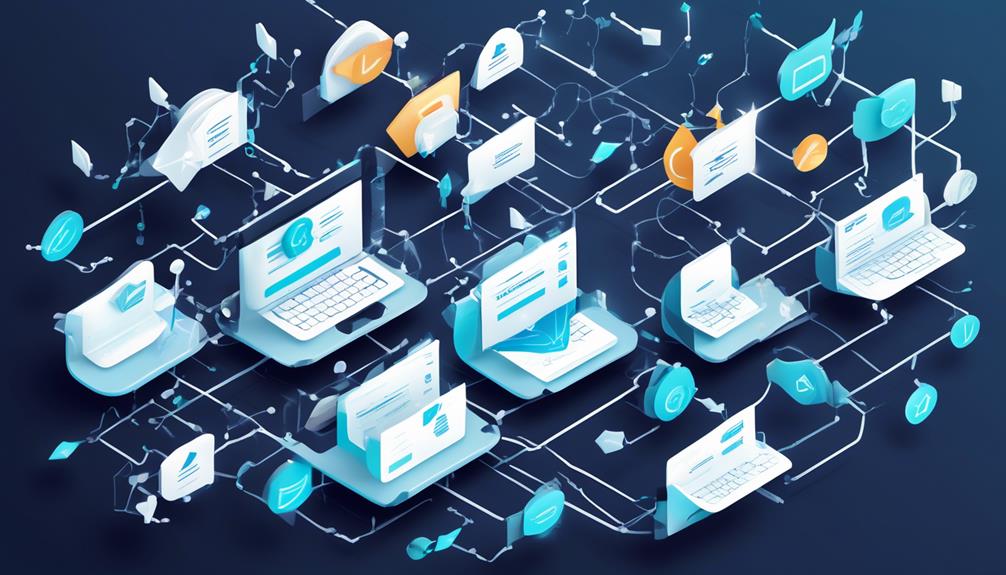
Incorporating personalized product recommendations and targeted content segmentation enhances the delivery of other content in email campaigns. By providing recipients with content that is tailored to their preferences and interests, marketers can significantly increase engagement and conversion rates. Segmenting email lists based on customer behavior, demographics, and purchase history allows for the delivery of more relevant and personalized content, leading to a more positive experience for the recipient.
| Personalized Product Recommendations | Targeted Content Segmentation | Enhanced Delivery of Other Content |
|---|---|---|
| Increases engagement and conversion rates | Delivers relevant content | Provides a positive recipient experience |
| Tailors content to recipient preferences | Utilizes customer behavior and demographics | Enhances email campaign effectiveness |
| Drives higher click-through rates | Improves personalization strategies | Boosts overall marketing campaign performance |
| Encourages repeat purchases | Enhances customer satisfaction | Strengthens brand-consumer relationships |
| Maximizes revenue potential | Increases email open rates | Drives long-term customer loyalty |
Incorporating personalized product recommendations and targeted content segmentation into email marketing campaigns not only delivers other content effectively but also contributes to the overall success of the marketing strategy. This approach not only enhances the recipient's experience but also drives higher engagement and conversion rates, ultimately leading to increased revenue and customer loyalty.
What Are the Best Practices for Implementing Email Automation Strategy?
When implementing an effective email automation strategy, it’s essential to segment your audience based on their behavior and interests. Personalize your emails to provide relevant content. Test different send times and analyze the performance to optimize engagement. Finally, monitor and refine your strategy regularly to ensure maximum impact.
Prompting Immediate Actions
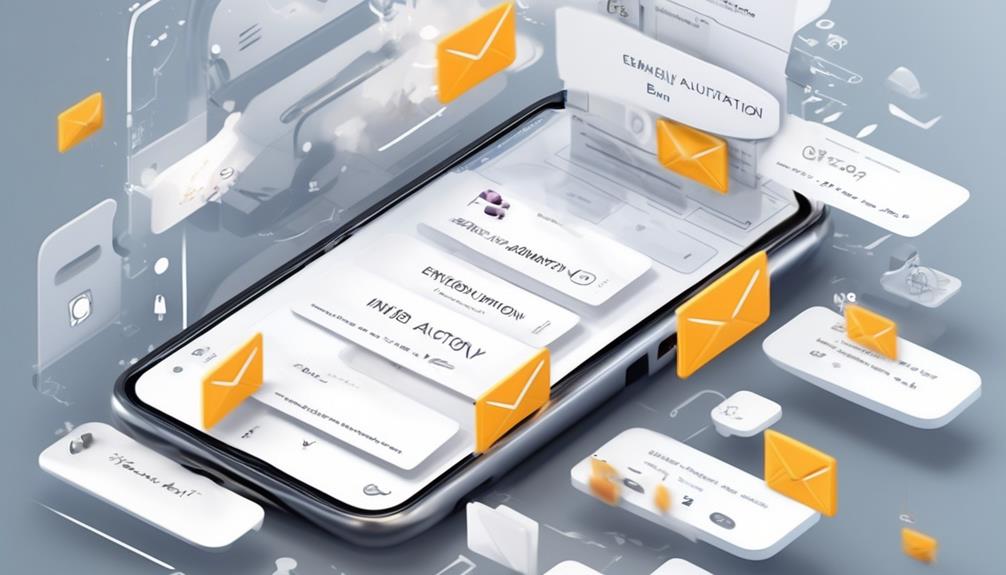
After tailoring content to recipient preferences and enhancing the delivery of other content, the next step is to prompt immediate actions through compelling calls-to-action and time-limited offers in email campaigns. Prompting immediate actions is essential for driving engagement and conversions.
Here are three key strategies to prompt immediate actions in email automation best practices:
- Clear Call-to-Action: Craft a concise and compelling call-to-action that clearly communicates the desired action and its benefits. Use persuasive language and strategic placement to capture the reader's attention and drive them to take immediate action.
- Urgent Language: Incorporate urgent language and time-sensitive phrases to create a sense of urgency and encourage immediate response. Highlight the limited availability of offers or time-limited promotions to prompt recipients to act promptly.
- Dynamic Content: Utilize engaging visuals and dynamic content to captivate the audience and drive immediate responses. Interactive elements, such as personalized product recommendations or interactive surveys, can prompt immediate engagement and action.
Frequently Asked Questions
How Do I Plan an Email Automation?
We plan an email automation by identifying our target audience and the types of workflows we want to implement.
We then map out the structure and branching paths of each workflow on paper before using automation software.
This helps us visualize the workflow and ensure it aligns with our goals and deadlines.
Having a visual representation also aids in understanding the branching paths and the number of emails needed for effective automation.
What Are the Steps in Email Automation?
We start by identifying our target audience and the types of workflows we want to implement.
Then, we plan the structure of each workflow, including branching paths and messages.
Mapping out the workflow on paper before using automation software helps with better visualization.
It's crucial to ensure that our workflow plans align with our goals and deadlines.
Having a visual representation also aids in understanding branching paths and the number of emails needed.
What Is Considered a Best Practice for Email?
In our experience, best practices for email include:
- Personalized content aligned with goals to boost engagement
- Cautious requests for valuable interactions
- Strategic use of entry triggers
Analyzing past performance and optimizing workflows is crucial. Segmented and personalized automated emails have significantly higher open rates.
These practices emphasize the importance of personalization and segmentation in successful email campaigns.
How Effective Is Email Automation?
Email automation is highly effective for engaging and nurturing leads. It saves time by sending targeted messages based on contact information and behavior. Personalization of content, senders, and subject lines significantly improves open and engagement rates.
We find it to be a crucial tool for efficient communication. Continuous analysis and optimization of past workflows are essential for enhancing its effectiveness.
Conclusion
As we wrap up, remember that successful email automation is a delicate balance of personalization and strategic planning. By carefully crafting workflows, personalizing content, and following up on customer behavior, we can build trust and engagement with our audience.
It's about finding the sweet spot between automation and human connection, and using the right tools to deliver value to our customers.
So, let's continue to refine our email automation practices and watch our marketing efforts thrive.
Erik – Email, SEO, AI Expert Writer Erik is the strategist, the thinker, and the visionary. His role at Influenctor is pivotal in integrating SEO with AI-driven content strategies. With an extensive background in email marketing and a profound understanding of search engine algorithms, Erik develops innovative strategies that elevate our client’s online presence. His work ensures that our content is seen, felt, and remembered.
Email Template
How to Create a Stunning Template in Mailchimp
Tune into this guide for step-by-step instructions on creating a captivating template in Mailchimp, and transform your email marketing game.
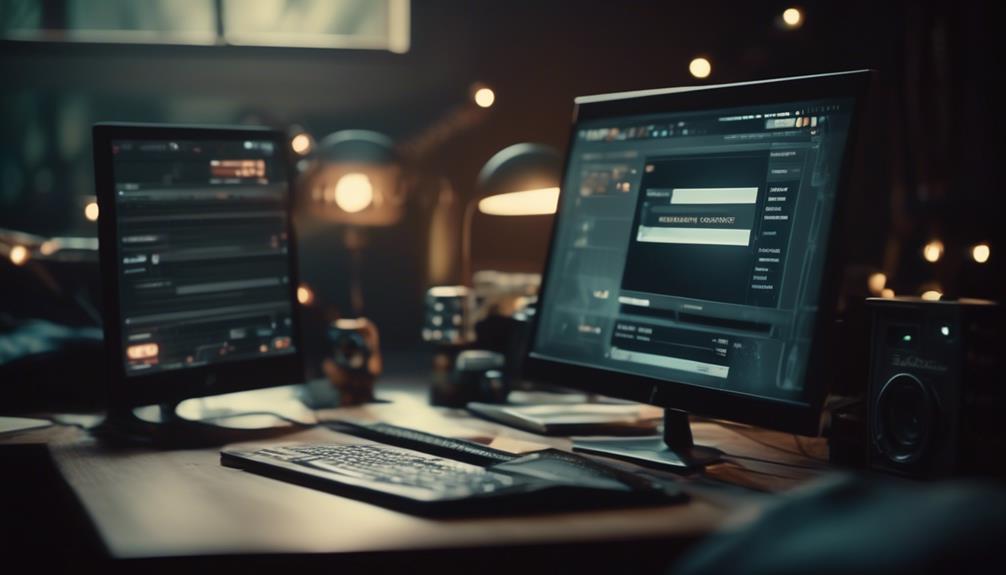
Designing a template in Mailchimp acts as laying the groundwork for a solid abode; it shapes the essence of all forthcoming correspondences. By selecting an appropriate template, you’re able to present a uniform and polished appearance in your emails, thereby simplifying the process of engaging with your audience.
But how exactly do you go about creating this essential framework? Let's explore the step-by-step process of choosing a layout, adding branding elements, and customizing your template to suit your unique needs.
By the end, you'll have a solid understanding of how to craft a template that reflects your brand and captures your audience's attention.
Key Takeaways
- Understand the differences between the new and classic builders in Mailchimp.
- Utilize merge tags and unique design elements to personalize and integrate branding elements.
- Save and regularly update custom templates to maintain brand consistency.
- Thoroughly test and finalize the template for consistency, responsiveness, and accuracy before sending campaigns.
Choosing a Layout
When choosing a layout for your Mailchimp template, it's important to understand the differences between the new and classic builders to make an informed decision.
Mailchimp offers two template builders: the new and classic builders. The new builder provides a more intuitive, drag-and-drop interface, making it easier to create and customize email templates. On the other hand, the classic builder offers more advanced customization options for users familiar with HTML and CSS. Understanding these differences is crucial in deciding which builder best suits your needs.
In addition, it's essential to consider the features available in each builder. The new builder allows you to use content blocks, merge tags, and create custom templates, while the classic builder offers advanced customization and the ability to test emails before sending them out. Considering these features will help you determine which builder aligns with your template creation requirements.
Ultimately, familiarizing yourself with the new and classic builders in Mailchimp will enable you to choose a layout that best complements your email marketing goals. Whether you prefer the simplicity of the drag-and-drop template or the advanced customization capabilities of the classic builder, understanding the options available is key to creating effective and visually appealing email templates.
Adding Branding Elements
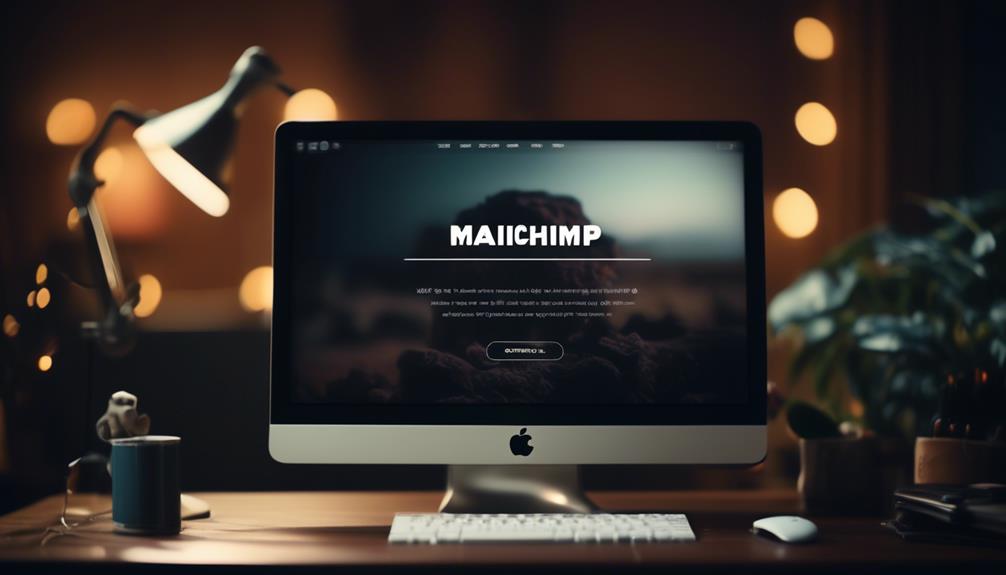
As we shift our focus to 'Adding Branding Elements', it's essential to ensure that the chosen template aligns with our brand identity and messaging. When creating a custom template in Mailchimp, it's crucial to incorporate branding elements that fit your brand and resonate with your audience.
Here are some key steps to add branding elements effectively:
- Utilize merge tags to personalize content and make it more engaging for your subscribers.
- Import HTML or paste in code to seamlessly integrate your brand's unique design elements into the template.
- Send a test email to yourself to ensure that the branding elements appear as intended and are consistent with your brand identity.
- Use the Template and Exit feature to save your custom template for future use, streamlining the process for subsequent campaigns.
- Regularly review and update your custom template to ensure that it continues to align with your brand and messaging.
Saving and Using Your Template
To effectively save and utilize your custom template in Mailchimp, follow these essential steps to ensure seamless integration and consistent branding across your email campaigns.
- After creating your Mailchimp template, it's crucial to save it for future use. In the new creator or classic creator, you can save your email as a template.
- Once saved, you can easily apply the template in the new creator or choose it in the classic creator, depending on the creator used.
- It's also important to regularly modify your template to keep it fresh and relevant. When making changes, save it with a new name and preview it to ensure everything looks as intended.
- Before sending any campaigns, it's advisable to test your template using the 'Send test email' option in the Email templates section to catch any issues beforehand.
- If you encounter any difficulties, remember that Mailchimp provides technical support through email and chat for paid users.
Customizing Your Template
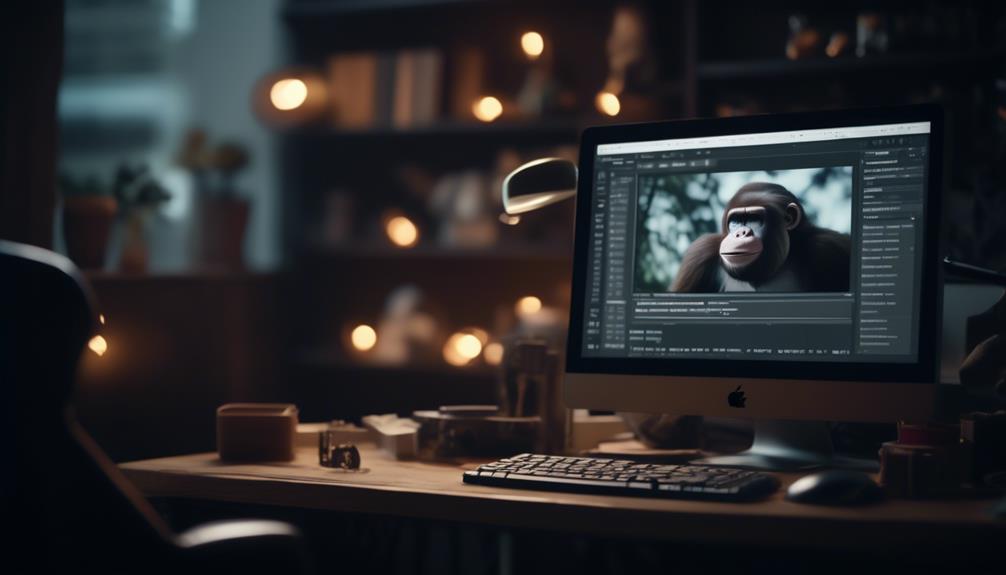
After saving and applying your custom template in Mailchimp, the next step is to tailor it to your specific needs by customizing its design and content.
When customizing your template, you can access the Email Templates section under Content and choose a template to start from, such as Saved templates, Mailchimp templates, or Code your own. Then, modify your template by clicking on Edit in the Email Templates section, making desired changes, and optionally saving it in the new or classic creator.
It's essential to test your template by sending a test email from the Email Templates section and preview it with the Enable live merge tag info option.
Additionally, seeking technical support through email and chat for paid users, and exploring related resources like Mailchimp's Email Template Language and importing custom HTML templates can be beneficial in customizing your template effectively.
Remember that templates are highly customizable to suit your brand and message, so make the most of Mailchimp's email builder and the customization options available on the Templates page.
Can I Use a Template in Mailchimp to Send Mass Emails?
Yes, you can send mass email with Mailchimp using their pre-designed templates. These templates make it easy to create professional-looking emails without any design experience. Simply select the template that fits your needs, customize it, and you’re ready to send your mass email campaign.
Testing and Finalizing Your Template
Let's ensure the effectiveness of your custom template by thoroughly testing and finalizing it to guarantee a seamless and impactful email campaign. Testing your template is a critical step in the process of creating an effective email marketing campaign. It ensures that your email displays correctly across various devices and email clients, and that all links and images are working as intended. Here's a basic checklist to guide you through testing and finalizing your template:
| Testing Aspect | Description | Action Needed |
|---|---|---|
| Layout and Formatting | Check for consistency and responsiveness | Adjust if necessary |
| Links and Buttons | Verify all links and buttons are working properly | Update if needed |
| Content and Images | Review content and images for accuracy and relevance | Edit as necessary |
Once you've tested your template and made any necessary adjustments, it's a good idea to finalize it by saving it as a reusable template on Mailchimp. By doing so, you can easily access and use it for future email campaigns, saving time and ensuring consistency in your branding and messaging. Testing and finalizing your template is just as important as customizing it, so take the time to make sure everything is in order before launching your email campaign.
Frequently Asked Questions
How Do You Create a Template in Mailchimp?
Creating a template in Mailchimp involves understanding the differences between the new and classic builders.
Familiarizing ourselves with image requirements for proper formatting is also important.
We can utilize filters, saved templates, or custom coding in the new builder.
For more design control, consider a custom-coded template and use Mailchimp's template language for a dynamic template.
Seek technical support and explore related resources for guidance.
How Do I Create a Custom Email Template?
Want to create a custom email template? We've got you covered.
Access Mailchimp's new builder to tailor your template exactly how you want it.
Our image requirements ensure a polished design, and you can even code your own template for ultimate customization.
Just be mindful that changes to custom-coded templates might affect existing campaigns.
With filters, saved templates, and custom coding, crafting a unique email template has never been easier.
Can I Upload My Own Template to Mailchimp?
Yes, you can upload your own template to Mailchimp. This allows for greater customization and branding.
Ensure your template meets Mailchimp's requirements for coding and design.
Once uploaded, use your custom template for future campaigns and maintain a consistent brand image.
This option provides more design control and flexibility to align with your brand's unique style and messaging.
How Do I Replicate a Template in Mailchimp?
Sure, replicating a template in Mailchimp is simple.
First, navigate to the Email templates section under Content.
Then, locate the template you want to replicate and select the 'Duplicate' option.
After that, you can make any necessary modifications to customize the duplicated template to your specific needs.
This approach allows for efficient creation of new templates based on existing ones, saving time and effort.
Can I Use the Stripo Email Template in Mailchimp?
Yes, you can use the Stripo email template in Mailchimp to create stunning email templates. Stripo offers a seamless integration with Mailchimp, allowing you to easily design and customize your emails in Stripo and then export them directly to your Mailchimp account for sending to your subscribers.
Conclusion
So, in conclusion, creating a template in Mailchimp is a breeze!
With the new or classic builder, you can easily add your own branding elements and customize the layout to suit your needs.
Once you've saved your template, you can use it for all your future emails.
And if you ever need any assistance, Mailchimp has plenty of resources available to help you out.
Give it a try and see how simple it can be!
Natali – Editor in Chief (Strategy and Mastery, AI Expert) Natali, our Editor in Chief, is the driving force behind our content’s strategic direction. With a keen eye for detail and a deep understanding of market trends, Natali ensures that our content is top-notch and strategically aligned with our client’s goals. Her expertise in AI helps to seamlessly integrate advanced technology into our marketing strategies, pushing the boundaries of conventional marketing.
Email Template
Crafting a Hotel Collaboration Email Template Guide
Master the art of crafting compelling hotel collaboration email templates to unlock a world of potential partnerships and free stays.
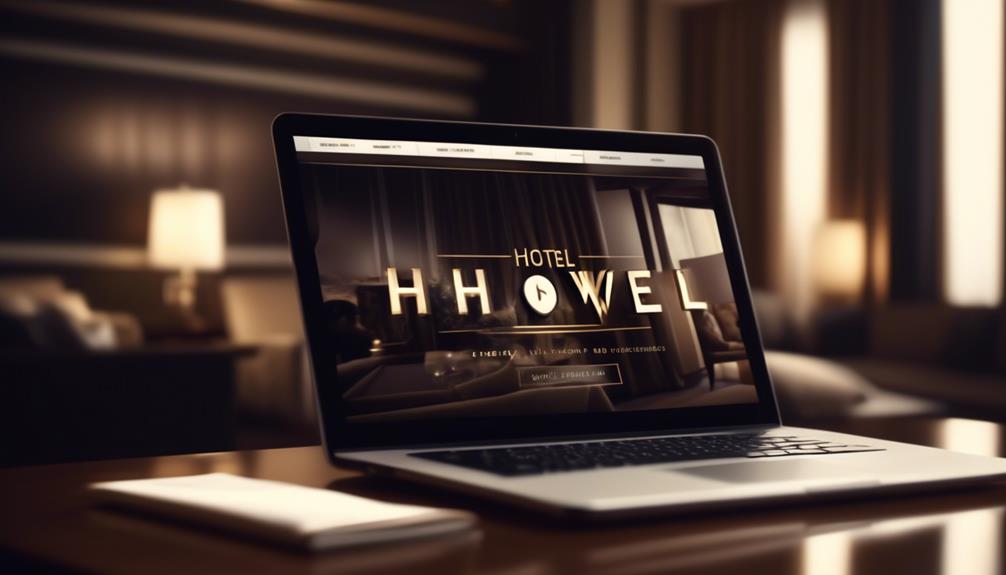
We’re all familiar with the phrase ‘you catch more flies with honey than with vinegar,’ and this holds particularly true when it comes to initiating contact with hotels for collaboration prospects. Developing the ideal email template could be the secret to opening up a realm of possible partnerships and complimentary accommodations.
But how do you ensure your email stands out from the rest and piques the interest of hotel decision-makers? Well, it all starts with a compelling subject line that grabs attention and makes them eager to learn more about what you have to offer.
But that's just the beginning of the journey toward successful hotel collaborations.
Key Takeaways
- Address the marketing manager by their first name, or use a generic salutation if the name is not available
- Keep the email content concise yet engaging, highlighting unique skills, audience, and platform
- Clearly outline the unique value proposition of the blog or platform, emphasizing expertise and credibility
- Recap the key benefits of collaboration, state next steps, and express gratitude for considering the collaboration
Crafting the Perfect Salutation
Crafting the perfect salutation is crucial for creating a strong connection with the marketing manager when reaching out to collaborate on hotel initiatives. Addressing the Marketing Manager by their first name, if available, adds a personal touch and shows attentiveness. When the name isn't available, using 'To The Marketing Manager: (Hotel Name)' still demonstrates a level of personalization.
Additionally, using 'Hey there!' as a casual salutation can maintain a friendly and approachable tone. Researching the names of the point person and using them in the salutation not only shows professionalism but also demonstrates attentiveness.
It's important to use the hotel's email address to make the email more personal and increase the chances of it being read.
Structuring an Effective Email Body
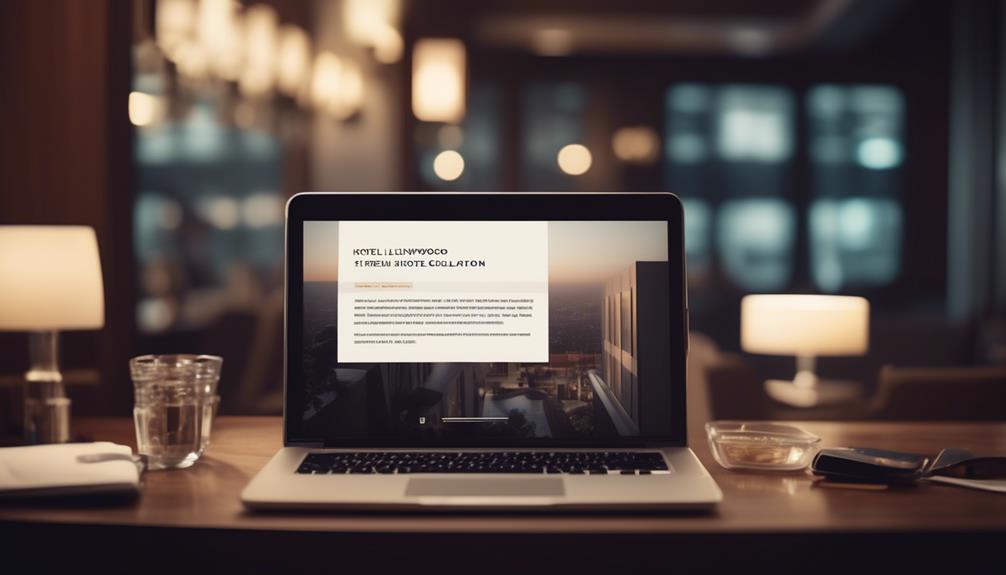
After establishing a strong connection with the marketing manager through a personalized salutation, we now shift our focus to structuring an effective email body that captivates the recipient's attention and conveys our collaboration proposal concisely.
When structuring the email body for a hotel collaboration, it's crucial to begin with a clear and attention-grabbing subject line that includes the hotel's name. This sets the tone for the rest of the email and entices the recipient to continue reading.
In the introduction, we should keep the content concise yet engaging, briefly highlighting our unique skills, audience, and platform to showcase our value to the luxury hotel. It's important to offer specific deliverables and ideas for collaboration in a professional manner, demonstrating how our social media following can benefit the hotel.
Personalizing each email to the specific hotel and its target audience is essential for creating a genuine connection and showing that we've taken the time to understand their brand.
Highlighting the X-Deal Details
Highlighting the X-Deal details allows us to showcase the unique value and expertise of our blog or platform, emphasizing our trusted resource status and previous successful hotel collaborations.
When approaching hotels with our X-Deal details, we highlight the following key points:
- Unique Value Proposition: Clearly outline the unique aspects and value of our blog or platform, demonstrating how we stand out from other influencers or platforms in the industry.
- Expertise and Credibility: Emphasize our expertise and trusted resource status by highlighting our previous successful hotel collaborations and showcasing any hotel reviews we've conducted in the past.
- Audience Engagement: Provide evidence of our loyal and engaged audience, such as statistics or testimonials, to illustrate the potential reach and impact of our collaboration.
- Promotional Reach: Offer to promote the hotel across multiple platforms, including social media, blog posts, and other media channels, underscoring the value we bring in terms of marketing and exposure.
Nailing the Closing Paragraph
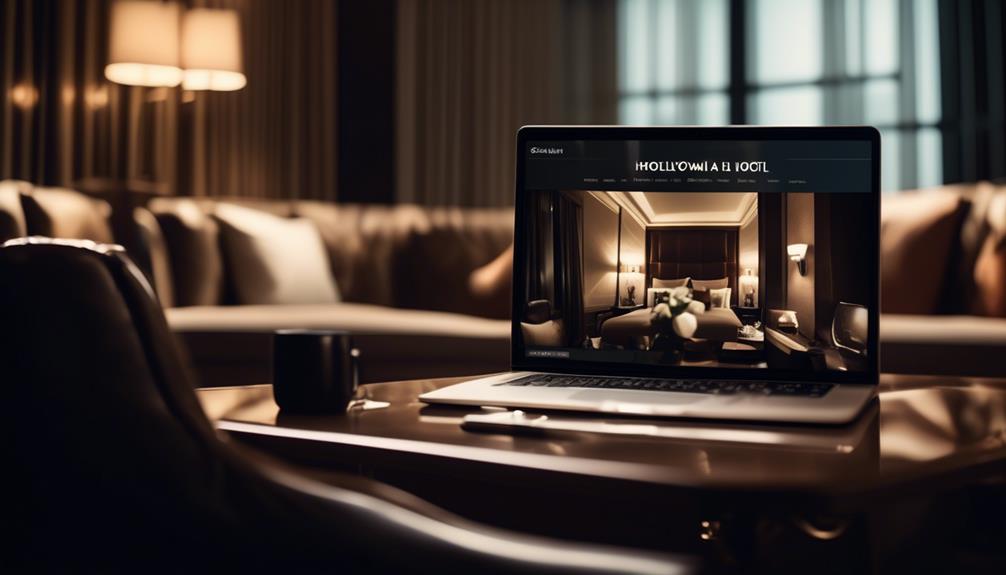
As we wrap up our X-Deal details presentation, it's essential to craft a compelling closing paragraph that leaves a lasting impact on the hotel and conveys our enthusiasm for a potential collaboration. The closing paragraph is the final opportunity to make a strong impression and prompt the recipient to take action. Here's an example of how we can structure the closing paragraph to maximize its effectiveness:
| Component | Description | Example |
|---|---|---|
| Recap of Benefits | Reiterate the key benefits of collaboration | Our collaboration promises increased brand visibility |
| Call to Action | Clearly state the next steps to initiate the process | Please feel free to reach out to us at [email address] |
| Expression of Thanks | Show gratitude for considering the collaboration | We appreciate your time and consideration |
| Follow-up Information | Provide links to relevant resources, such as a blog post | For more details, you can visit our recent blog post [link] |
Tips for Pitching a Free Hotel Stay
When reaching out to hotels for a complimentary stay, it's crucial to clearly articulate the value and benefits we can offer in exchange for their hospitality. Here are some tips for pitching a free hotel stay effectively:
- Showcase Your Reach: Highlight your strong social media presence, website traffic, and engagement metrics to demonstrate the potential exposure their hotel could receive.
- Emphasize Relevant Experience: Discuss your background in reviewing hotels and resorts, emphasizing your ability to create compelling and authentic content that will resonate with your audience.
- Offer Unique Collaboration Ideas: Propose innovative ways to showcase the hotel, such as hosting a giveaway, organizing a social media takeover, or creating a video tour of the property.
- Express Gratitude: Communicate genuine enthusiasm for the opportunity to collaborate and convey your commitment to delivering high-quality content that aligns with the hotel's brand.
Frequently Asked Questions
How Do You Write an Email to a Hotel for Collaboration?
We are writing to introduce ourselves and our company. We are interested in a partnership with your hotel and would like to explore the potential benefits for both parties.
Our company is [Company Name], a [description of your company and its unique aspects]. We believe that a collaboration with your hotel could be mutually beneficial.
By working together, we can leverage our expertise in [relevant field] to enhance the guest experience at your hotel. Our services/products can [explain the specific benefits or improvements that your company can bring].
A partnership with us would not only add value to your hotel but also provide us with an opportunity to showcase our brand to a wider audience.
We would be happy to discuss this further and explore how we can create a successful partnership that meets the needs of both parties.
Thank you for considering our proposal. We look forward to hearing from you.
How Do You Write an Official Email for Collaboration?
We write official collaboration emails by crafting a compelling subject line to grab attention and addressing the recipient personally.
We clearly state what we can offer and cross-reference with relevant information.
Emphasizing our expertise and trusted resource status showcases our value.
We also highlight our skills and platform to demonstrate the unique aspects of our blog.
This approach ensures our email stands out and effectively communicates our collaboration proposal.
How Do You Pitch a Collab With a Hotel?
Pitching a collaboration with a hotel involves showcasing our platform's value and aligning with the hotel's target audience. By emphasizing our high traffic and offering valuable content and promotional support, we can secure a free stay in exchange for exposure.
Personalizing the pitch with a catchy email subject and choosing hotels that resonate with our audience's interests increases our chances of success. It's about presenting our skills and platform as a professional opportunity.
How Do You Write a Professional Email for a Hotel?
We write professional emails for hotels by crafting attention-grabbing subject lines and clearly articulating our blog and social media value.
Personalizing each email to the specific hotel and proposing collaboration offerings is crucial.
Researching and selecting hotels that align with our audience's interests maximizes impact.
Persistence is key, while politely declining unfair terms showcases our value.
Conclusion
Just like a well-crafted symphony, the Hotel Collaboration Email Template orchestrates a harmonious melody of personalized salutations, compelling body content, and irresistible x-deal details.
With the perfect crescendo in the closing paragraph, this template hits all the right notes to pitch a free hotel stay.
By following these tips and techniques, you'll be conducting successful collaborations with hotels in no time.
Let the music of partnership and opportunity play on!
Natali – Editor in Chief (Strategy and Mastery, AI Expert) Natali, our Editor in Chief, is the driving force behind our content’s strategic direction. With a keen eye for detail and a deep understanding of market trends, Natali ensures that our content is top-notch and strategically aligned with our client’s goals. Her expertise in AI helps to seamlessly integrate advanced technology into our marketing strategies, pushing the boundaries of conventional marketing.
How to Write Email
How to Write a Professional Email Reminder to Your Professor
Frustrated with unanswered emails? Learn how to craft a compelling reminder email to your professor for a prompt response.

We’ve all experienced it – a hectic week filled with numerous tasks, and then suddenly, the project deadline is just around the corner. You find yourself in need of some essential details from your professor, yet there’s been no reply to your first email.
Crafting a reminder email to your professor can be a delicate task, requiring a balance of assertiveness and respect. It's essential to consider the best approach to ensure your message stands out without coming across as pushy or demanding.
So, how do you strike that balance and ensure your reminder email gets the attention it deserves? Well, let's explore some effective strategies to master the art of writing a reminder email to your professor.
Key Takeaways
- Clearly explain the reason for the follow-up
- Reiterate the importance of the matter
- Express gratitude for the professor's time and attention
- Reflect positively on the sender
Understanding the Purpose
Understanding the purpose of writing a reminder email to a professor is essential for effectively communicating your needs and showing respect for their time. When crafting a polite follow-up email to a professor, it's important to ensure that the email serves as a gentle reminder rather than an imposition.
The original email likely mentioned getting in touch for a specific reason, and a polite follow-up can help speed the process along. It's important to clearly explain the reason for the follow-up, reiterating the importance of the matter and expressing gratitude for the professor's time and attention.
In writing a reminder email to a professor, the key is to be respectful and considerate. It's crucial to avoid sounding demanding or entitled and instead, convey a tone of appreciation and understanding. By doing so, the email not only serves its purpose of gently reminding the professor but also reflects positively on the sender.
Understanding the purpose of the email and approaching it with a polite and respectful tone is fundamental in effectively communicating with professors.
Setting the Right Tone

When composing a reminder email to a professor, it's crucial to set a respectful and professional tone that aligns with the formality of the professor's communication style. This ensures that the email conveys courtesy and appreciation for the professor's time and expertise.
To achieve this, consider the following:
- Be courteous and polite: Express gratitude for the professor's guidance or feedback in your email.
- Use respectful language: Address the professor using their appropriate title and maintain a formal tone throughout the email.
- Show consideration for the professor's time: Keep the email concise and to the point, demonstrating that you value their time.
- Convey enthusiasm and eagerness: Express your genuine interest in receiving feedback or a reminder of your request, showcasing your dedication to the subject matter.
Structuring Your Email
Regarding the structuring of your email, emphasizing clarity and directness in your communication will ensure your message is effectively conveyed to the professor.
When composing a reminder email to your professor, it's crucial to structure it in a clear and organized manner.
Begin with a concise and specific subject line that reflects the purpose of your email, such as 'Follow-Up on Meeting Request.'
In the greeting, address the professor using their formal title and last name, for example, 'Dear Professor Smith.'
Clearly state the context of your email and reference any previous communication to provide a reminder of the original discussion or request.
Be explicit about what you're asking the professor to do, whether it's scheduling a meeting, providing feedback, or submitting an assignment.
End the email with a polite closing, such as 'Thank you for your time and attention' or 'Best regards,' followed by your name.
Structuring your email in this manner will ensure that your message is respectful, clear, and easily understandable to the professor.
Polishing Your Email

In crafting a polite follow-up email to your professor, it's essential to pay attention to the finer details of your message, ensuring that it reflects professionalism and respect while effectively conveying your purpose. Polishing your email involves refining the language and structure to create a compelling and respectful message.
Here are some key aspects to consider:
- Tone: Ensure the tone of your email is respectful and courteous, maintaining a professional demeanor throughout the message.
- Clarity: Double-check for any grammatical errors, typos, or confusing language that may detract from the clarity of your email.
- Conciseness: Keep your email brief and to the point, respecting the professor's time while still conveying your request effectively.
- Gratitude: Express your gratitude for the professor's time and consideration, reinforcing a positive and respectful tone in the email.
Ensuring Professionalism
We maintain a formal and respectful tone in our email communications with professors to ensure professionalism and convey our message effectively. When writing a reminder email to a professor, it's crucial to uphold a high level of professionalism. This includes using a clear and concise subject line that accurately reflects the purpose of your email.
Proofreading for spelling and grammatical errors is essential, as these can detract from the professional image you want to project. It's important to avoid using casual language, slang, or emoticons in your communication, as these can be seen as unprofessional.
Expressing gratitude and appreciation for the professor's time and consideration is also key to maintaining a professional tone. Furthermore, it's a good practice to reiterate any important points in your email to ensure that your request is received and addressed.
Frequently Asked Questions
How Do You Politely Send a Reminder Email?
We politely send a reminder email by acknowledging the recipient's busy schedule.
We express our understanding of their workload and reiterating the importance of the matter at hand.
It's crucial to maintain a respectful tone and avoid sounding demanding.
We can also offer additional assistance or information if needed, showing our willingness to collaborate.
Ultimately, a polite reminder email conveys our professionalism and consideration for the recipient's time.
How Do You Politely Resend an Email to a Professor?
We politely resend an email to a professor by first reviewing the original message for clarity and conciseness.
Then, we craft a polite follow-up email, acknowledging the previous correspondence and restating the request or question.
It's important to express understanding of their busy schedule and to offer flexibility for a response.
This demonstrates professionalism and respect for the professor's time while ensuring the message is received.
How Do I Write an Email With a Reminder?
We write reminder emails to professors to prompt a response or follow-up on a previous email. It's important to be polite and professional in our approach, considering the professor's busy schedule. We can mention the original email, express gratitude, and restate our request clearly.
Avoid being pushy or demanding. A well-crafted reminder email can help us maintain a good rapport with our professors and ensure our needs are addressed.
How Do You Say Reminder in a Formal Email?
In a formal email, a polite way to say 'reminder' is by using phrases like 'just a gentle nudge' or 'a quick follow-up.' These expressions convey the message respectfully without coming across as pushy or demanding.
It's important to maintain professionalism and courtesy when sending reminders to professors. By using considerate language, we can effectively communicate our need for a response while showing respect for the recipient's time and priorities.
Conclusion
As we craft our reminder email to our professor, let's remember to approach it with the gentle touch of a painter, delicately adding the final strokes to create a masterpiece.
Our words should be like a soothing melody, resonating with gratitude and respect.
With each carefully chosen phrase, we paint a picture of professionalism and consideration, ensuring our message is received with warmth and understanding.
Erik – Email, SEO, AI Expert Writer Erik is the strategist, the thinker, and the visionary. His role at Influenctor is pivotal in integrating SEO with AI-driven content strategies. With an extensive background in email marketing and a profound understanding of search engine algorithms, Erik develops innovative strategies that elevate our client’s online presence. His work ensures that our content is seen, felt, and remembered.
-

 Email Automation2 weeks ago
Email Automation2 weeks agoAutomated Email Marketing 101: A Beginner's Tutorial
-

 Email Warmup4 weeks ago
Email Warmup4 weeks agoWarm Follow-Up Email
-

 Email Design Hub1 month ago
Email Design Hub1 month ago3 Essential Tools for Email Marketing Design Success
-

 Email Marketing3 weeks ago
Email Marketing3 weeks agoWhat Is Email Marketing Advantages and Disadvantages
-

 Email Marketing3 weeks ago
Email Marketing3 weeks agoWhy Email Marketing Is Effective
-

 Email Template3 weeks ago
Email Template3 weeks agoCrafting the Perfect Book Club Invitation Email Template
-

 Email Marketing3 weeks ago
Email Marketing3 weeks agoDoes Email Marketing Work in 2024
-

 Search Engine Optimization3 weeks ago
Search Engine Optimization3 weeks agoSEO Checklist: Enhance Your Site’s Performance

















